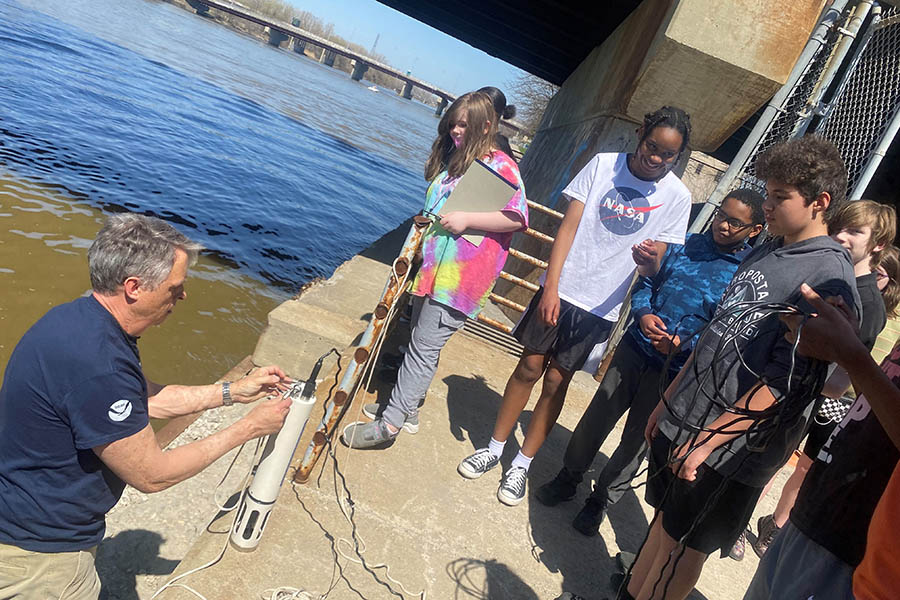
Middle school students and teacher preparing to deploy a Hydrolab.
This page provides data sheets, lesson plans, teaching resources, and NGSS connections that can support water quality investigations with middle school students. For questions about these educational resources or to share your own lessons with the Limno Loan community, please contact IISG’s Great Lakes educator.
Grade: 8
Time to Complete: 5 class periods
This multi-day lesson plan was developed by a Limno Loan educator. The lesson leads students through the collection of limnological and ecological data in a pond ecosystem to determine its overall health. The students can add their data to larger sets of data to compare their pond to a Great Lake or ocean.
Grades: 4–8
Time to Complete: 1–3 hours
This series of five lessons is from Fisheries Learning on the Web and was developed by Michigan Sea Grant. The first two activities allow students to predict, observe, and explain the movement of water. Lessons 3 and 4 discuss the relative availability of freshwater on the planet and why water quality is so important. In the final lesson, students have an opportunity to make their own decisions concerning water quality, land use, and the environment.
Grades: 4–8
Time to complete: 1 hour
This NGSS-aligned activity from Michigan Sea Grant helps students think about different ways to determine water quality. Students make observations and measurements of several water samples.
Grades: 5–7
Time to complete: 1–3 hours
This NGSS-aligned lesson is composed of two activities that allow students to explore thermal stratification and dissolved oxygen levels by graphing water quality data from Lake Erie.
There are many ways the Limno Loan program can support NGSS. This is one example for middle school water quality investigations.
MS-LS2 Ecosystems Interactions, Energy, and Dynamics:
• Cause and Effect. Cause and effect relationships may be used to predict phenomena in natural or designed systems. (MS-LS2-1)
• Stability and Change. Small changes in one part of a system might cause large changes in another part. (MS-LS2-4)
Science Knowledge is Based on Empirical Evidence: Science disciplines share common rules of obtaining and evaluating empirical evidence. (MS-LS2-4)
Students will be using water quality equipment to investigate water quality parameters in the field. Students will collect data using a sampling protocol. Students can graph and read water quality data and then examine the relationship between two or more parameters.
Students will learn that water quality parameters can be used to examine the interrelationship between these variables and how they shape the physical, chemical and biological components of the water body being studied. Aquatic ecosystem populations can be impacted by changes in water quality parameters.
Waterbodies can be described by their chemical and physical properties. These parameters are measured in standard units and can change over time. Changes to one water quality parameter can affect another parameter. The health of the water body can impact the ecosystem as a whole.
Students can interpret data products generated to investigate their water quality research question. Students can use these data interpretations to construct an argument about how water quality can impact an ecosystem.
The following data sheets are from fellow Limno Loan educators and can be downloaded and revised to fit your needs.
Microsoft Word:
Google Docs:
Support learning and understanding of water quality parameters with the following tools.
Water Quality Parameters Primer
Each aquatic habitat is different but this chart can be used as a generalized guide to assist students in interpreting ideal data ranges, danger readings, and causes of and remedies for water pollution.
These simple cards outline each of the seven water quality parameters that the Limno Loan program can help you measure. They can be printed and folded in half to create a set of flashcards that students can use in cooperative learning groups.

Limno Loan
c/o Illinois-Indiana Sea Grant
Purdue University
195 Marsteller Street
West Lafayette, IN 47907-2033
Phone: 765-496-6009
Email: iisg@purdue.edu
This program is administered by Illinois-Indiana Sea Grant and funded by the Great Lakes Restoration Initiative via cooperative agreement between the U.S. EPA Great Lakes National Program Office and the National Oceanic and Atmospheric Administration.
© 2023 Illinois-Indiana Sea Grant.
All Rights Reserved.
Illinois-Indiana Sea Grant strives to ensure equal access and an inclusive environment.
Designed by Studio 2D